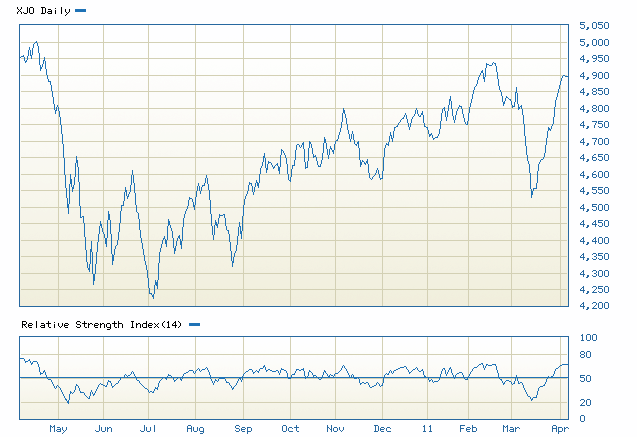The Australian market’s S&P/ASX 200 only rallied 1% in the first three months of the year, compared with 5.4% for the S&P 500 in America. With the $A seemingly headed to $1.10, foreign investors, abut two fifths of the market, are likely to get nervous, and the strengths of the Australian market are probably priced in. There also seem to be plenty of weaknesses. A quarterly report by Morningstar has tracked earnings per share (EPS) trends in the share market, and it reveals a pattern of low growth, after resources and energy stocks are taken out. With most portfolios now positioned to price in the growth in energy and mining demand, it raises the question of what else is worth investing in. Debt is historically low, which reduces the risk. But earnings growth is also likely to be low, which reduces the incentive. Morningstar has a prospective dividend yield of 4.2 per cent which is certainly competitive with other types of investment. The forward earnings multiple of 15.5 is about mid range. But the slower half of the two speed economy is looking pretty pedestrian.
The report says:
We forecast FY11 EPS growth at 29.5%, followed by 18.9% growth in FY12. While these numbers may appear impressive, the bulk of the gains are forecast to come from the mining and energy sectors from ongoing strong volume demand
and continuing robust pricing, despite the strength of the A$ which naturally correlates with commodity prices.
The median EPS growth forecasts paint a somewhat more sobering picture with FY11 EPS growth of 9.4% and FY12 of 12.4%. Clearly, removing mining stocks such as BHP (67.7% & 19.0%), RIO (51.1% & -3.1%) and FMG (126.6% & 1.2%) from the equations changes the earnings profile landscape for the remainder of the market, particularly in the Industrial sectors.
Looking at Morningstar’s EPS sector predictions there is quite a bit of volatility. Media EPS, for instance, was down 40% last financial year, 1% this year and a more stable 10% next financial year. Retailing has fallen off a cliff as the stimulus packages were withdrawn: 17% last financial year, 0.9% this. But that has been priced in. The 2011-2012 predictions are interesting. Insurance EPS is forecast to grow 58% next financial year; while transportation EPS is predicted to fall by 34%. Capital goods EPS is predicted to rise 58% next financial year. There may be trading opportunities there.
Morningstar’s general strategy is to be careful given the global volatility and threats. This is hardly news. Morningstar says:
With elephants all around, now is a time for vigilance, prepared for a left field stampede but at the same time disciplined to take advantage of opportunities as they arise.
1 To guard against the ongoing uprisings in the middle-east / northern Africa, a balanced portfolio should have some gold and carbon based energy exposure.
2 To protect against QE2 ceasing and no QE3 taking its place, cash weightings should be higher than usual in the short term, should a repeat of mid 2010 take place.
3 To insulate against the European economic situation deteriorating further, some strong, well managed domestic businesses with secure cash flow, profitability and dividend profiles.
Strong, resource based companies with low operating costs and strong customer links with China is suggested. If China’s economic expansion slows more than expected, causing commodity prices to slip, mid-cap resources will tend to decline at a greater rate. While we do not believe this to be a base case, some balance of upside and downside risks are warranted. General weakness or a set-back in the US economic recovery can be avoided by focusing on staple industrials with a high domestic focus. Domestic retailing remains soft, as does the outlook for building materials (incorporating exposure to the US construction market).
4 Natural disaster related impacts are largely time-frame dependent. Relatively minor impact expected from the Japanese earthquake and associated tsunami with some short to medium term beneficiaries being thermal coal and LNG producers. Iron ore and base metal producers to benefit in the medium to longer term as reconstruction gets underway. Uranium producers have seen a fall in the spot uranium price while port and logistics companies may see reduced import / export volume movements in the short term.
Morningstar is overweight Energy, Financials, IT, Materials and Telecommunications Services, with a bias to big stocks. Financials is a questionable sector; the banks are not likely to have huge upside and if Deep T and my co-bloggers are right, may have spectacular downsides. Telcos is also a doubtful sector, although Telstra has a big dividend. The main hope for big capital gains is in M&As and the high currency will deter foreign predators. Making good individual stock picks looks like the emphasis.
